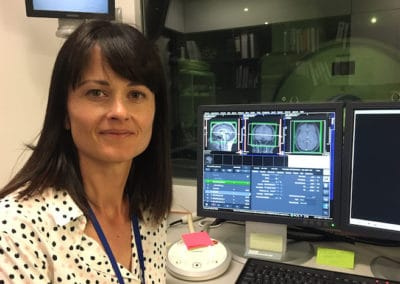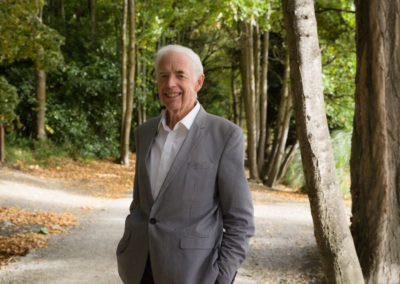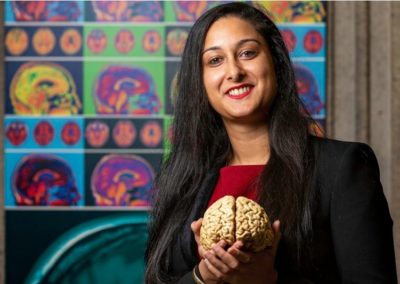This article was originally published by the Brain Health Research Centre [http://www.otago.ac.nz/bhrc/news/otago608623.html]
Russell Snell is a pioneering geneticist. He was part of the team which first identified the gene for Huntington’s disease. That was more than 20 years ago. These days he splits himself between projects on three disorders: Huntington’s, Alzheimer’s, and autism. He is, understandably, a very busy man, but his quiet voice and relaxed speech would never give that away.
“What I’m talking about today isn’t difficult,” he says, “the techniques are certainly complicated, but the concepts are all very simple.” It’s an easy statement for an expert to make, but Russell is adamant that if the crowd do not understand something it is not their fault, “it will be my fault for not explaining it correctly,” he says.
He takes us through the identification of the Huntington’s gene, HTT, in 1993. The gene is present in every person in the room, but for 1 in every 10,000 people it will cause the development of Huntington’s disease. Who gets the disease, and who does not, is determined by the code of the gene. If a section of the code is repeated too many times it will cause Huntington’s disease to develop. They can test for this now, thanks to Russell Snell and his team, people can check ahead of time whether or not they will develop the disease, but there is still no cure.
That’s what he’s working on now. With the help of a new international team Professor Snell has developed a sheep model for Huntington’s disease, in order to try new treatments. The sheep have a version of the Huntington’s gene which will cause the disease to develop, and Russell is optimistic about the information this will provide. He has a theory that the faulty Huntington’s gene changes how metabolic by-products are dealt with in certain parts of the brain. “It’s just an idea,” he stresses, “we don’t have the data yet, but if it is true is would be a miracle.” Why? Because there are already treatments available for this kind of metabolic problem. If Russell Snell’s sheep confirm his theory, he could cure Huntington’s disease.
Those aren’t the only sheep in his paddock, however, he’s also trying his hand at treating Alzheimer’s disease. He tells us that the key to understanding Alzheimer’s is to look at the genes of people with an early onset of the disease. When you look at the genes of these people you get a condensed version of what is causing the disease, because the progress of the disease is much faster. “In these cases,” he says, “there is always a problem with a gene relating to amyloid precursor protein.” Amyloid may sound familiar; it is a build-up of amyloid which is so often observed in the brains of people with Alzheimer’s. Amyloid-precursor protein is the protein which is cut up within the brain to create amyloid, and if there is a problem with this protein then there will be problems with the amyloid it creates.
Russell Snell’s Alzheimer’s sheep have been given a genetic mutation which messes with amyloid-precursor protein. “We can measure the levels of these proteins by taking fluid from the animal’s spinal cord,” he says, “so we can try different treatments and see which ones are effective in reducing the protein.” It’s a step toward another cure, a way for researchers to see how and why a disease develops so that they can stop it before it takes hold. Professor Snell is cautiously optimistic about his work, he explains it as clearly as he can but stops every now and then to remind the crowd that these aren’t treatments yet, these are just ideas. He wants to build a healthier world, but we’re not there yet.
Both of Snell’s sheep models are meant to gather information about diseases of age, diseases we could not cure if they developed past a specific point. He turns our attention toward something different, a disorder typically associated with the young: autism. Professor Snell is running a study at the moment which aims to sequence the genomes of over 1500 people who suffer from autism. There are over 100 genes associated with the disorder, and they all mean different things. Some of these gene mutations are passed on from parents to their children, and some are not, by identifying these genes Professor Snell and his team can give parents an idea about how likely their future children will be to develop the disorder. There are three gene variants which can be treated, restoring function to children who were previously severely hindered by the disorder. “Gene sequencing is the new medicine” Professor Snell tells the crowd. For around $1000 a person’s entire genome can be sequenced, and their treatments can be targeted specifically toward the cause of the issue. It’s not common practice yet, not even in the research world, but for those families in Professor Snell’s study it has been life changing.
While he does seem impatient for progress in disease treatment, he is realistic about the future. “In five years’ time,” he says, “I would be surprised if we didn’t have some good first base treatments for Alzheimer’s, Parkinson’s, and Huntington’s.” He sounds sure, and I have no reason to doubt his optimism. With researchers like Russell Snell on the case it feels like a very achievable future.



